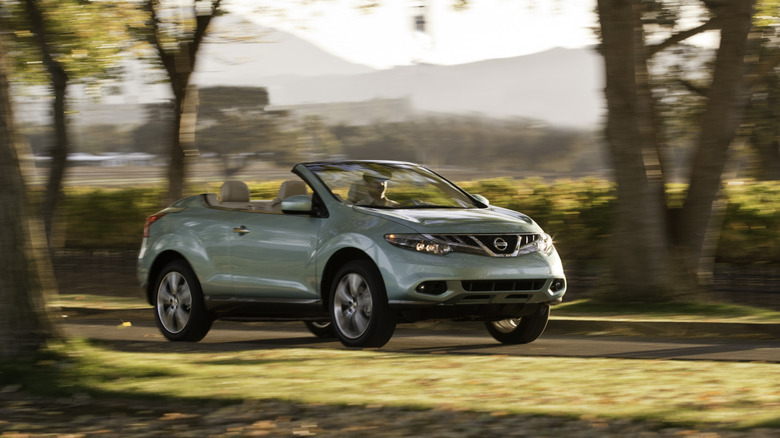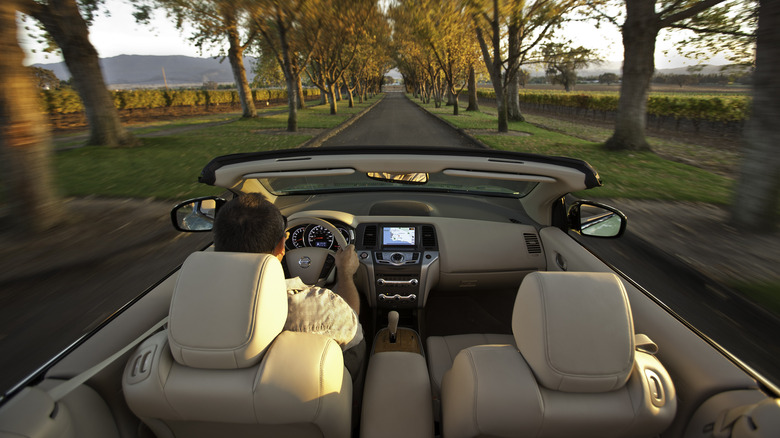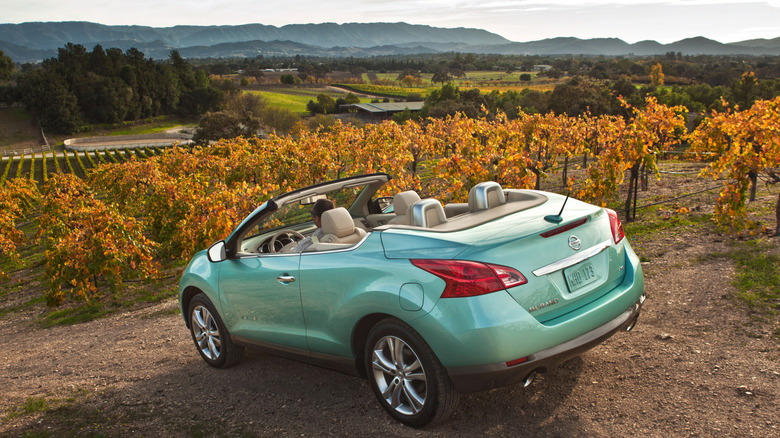Why Nissan Discontinued This Weird Convertible SUV
The Nissan Murano CrossCabriolet may have been one of the most bizarre automotive decisions in recent memory, but it didn't come out of nowhere. The convertible's origin goes back to a personal request from then-CEO Carlos Ghosn's wife. Ghosn greenlit the CrossCabriolet after his wife, Rita Kordahi, expressed her desire to experience the thrill of open-air driving in the practical package of a Murano. Ghosn, notorious for indulging in eccentric executive decisions during his 16-year reign at Nissan, handed the idea over to the design and engineering teams with a two-year deadline. And so, a convertible crossover — something the market hadn't asked for — was born, joining the ranks of other Nissan convertibles like the Micra C+C.
As the car evolved from concept to production, its target demographic became clearer: upmarket, older buyers looking for something unique. But while the intent was certainly ambitious, the execution left much to be desired. Going convertible meant that the Murano CrossCabriolet lost its structural rigidity, practicality, and refinement. Chassis bracing couldn't fully make up for the compromised body, leading to noticeable flex and shuddering over bumps and diminished handling.
Even worse, it sacrificed several key features of an SUV. The rear seats were cramped, trunk access was limited due to the folding soft top, and its outward appearance — an awkward fusion of high-riding SUV and squashed convertible — made it the laughing stock of the early 2010s. Nissan had gambled on novelty, but buyers weren't sold.
The Murano CrossCabriolet answered a question nobody asked
From the moment it hit showrooms in 2011, the Nissan Murano CrossCabriolet was a curiosity — and an expensive one, too, with a starting price north of $45,000. But behind the high sticker and flashy exterior lurked a vehicle with conflicted identities. It was neither a competent SUV nor a truly satisfying convertible. The CrossCabriolet needed heavy reinforcement to compensate for the structural integrity it lost by ditching the roof, but those efforts came at a cost — namely, added weight and compromised comfort.
Worse yet, the CrossCabriolet's ride height and proportions made it awkward to drive. Its handling felt clumsy compared to most convertibles, and the suspension, tuned for softness, made cornering a scary experience. The rear seats were hard to access due to the two-door design, and its trunk space shrank dramatically when the top was down. Its cargo space also suffered, as the roof mechanism took up considerable room in the trunk. For something that was supposed to blend SUV utility with the top-down rush, it failed to do either job well.
Critics were ruthless. It quickly became the butt of internet jokes and late-night show segments. While Nissan hoped its uniqueness would draw attention, it seemed most buyers just didn't understand who the CrossCabriolet was for. By 2014, the experiment was quietly ended due to poor sales. The CrossCabriolet ended up as another entry in the history of discontinued Nissan cars, a retreat from one of the boldest misfires in the company's history.
A laughing stock turned cult classic
Today, the Nissan Murano CrossCabriolet lives on as a cult classic — a reminder of how wild car design and features can toe the line between genius and absurdity. Initially mocked, the Murano CrossCabriolet eventually gained appreciation from collectors and enthusiasts who valued its scarcity and boldness. As of 2018, demand for used models remained surprisingly strong, particularly among convertible fans who wanted something with a bit of character.
The CrossCabriolet may have flopped in the showroom, but it succeeded in one respect: it proved that automakers were still willing to take risks. In an era when many cars are criticized for looking too alike, Nissan's experiment at least stood out. Whether it stood out for the right reasons is still up for debate.
Ultimately, the Murano CrossCabriolet is a cautionary tale. It tried to blend two automotive genres without fully committing to either, resulting in a vehicle that appealed to very few. But in the process, it carved out a unique chapter in Nissan's history — one that might just be appreciated more in hindsight than it ever was when it was new.


